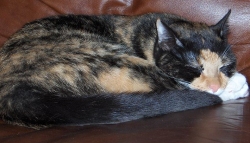Why are all tortoiseshell cats female?

What is a tortoiseshell cat? The tortoiseshell is a beautiful coat colouring which gives a cat brown, black, orange or cream parches on its fur. 'Calico cats' are also tortoiseshells, though they have specifically white fur with red or brown patches. People with tortoiseshell cats love their 'torties', and some decide that they want to breed theirs. Yet when they look around for a male tortoiseshell to mate their cat with, there's a surprise waiting. Unlike tabby or seal point colourings, the tortoiseshell coat pattern is for girls only! Now why is that?
Well, cat coat colouring is all about genetics. And yes, Torties have very specific genes which determine their colours. These genes are found in the chromosomes on the DNA. (Chromosomes are the long threads that make up the famous DNA spiral.) Now there are two types of chromosome - the X chromosome and the Y chromosome. Most females have two X chromosomes in their DNA, and most males are XY. With me so far?
Let's move quickly to the punch line. The genes which a cat needs to make a tortoiseshell coat are on the X chromosome. Not a problem because males also have an X chromosome. However, female cats have two X chromosomes, and as will be seen, for a tortioseshell kitten to be born, both these X chromosomes are going to be needed.
With a male cat-to-be, the X chromosome has the right allele, so you can get a black male cat, or a marmalade cat, but without the other X chromosome, you can't get both colours on the one cat. So sorry, no Tortie.
That's the basics. Now let's play some genetic noughts-and-crosses to see exactly how these match-ups produce particular shades, and some other fun stuff which keeps cat breeders awake at night.
For example, you can very occasionally get a male tortoiseshell cat, for the same reason that you can sometimes find a human man with XX chromosomes. These rare individuals have an extra strand of DNA, and are in fact XXY. In such cats, the two Xs give a the possibility for a tortoiseshell coat, while the Y means the cat will be male.
Now let's start our noughts-and-crosses with the O gene, which stands for Orange. That's the gene which tells the cat's body to produce orange melanin. (Your human body produces brown melanin, which is why you get a suntan.) However, the allele might be 'o' instead of 'O'. (The small o means 'not orange'). An Xo allele produces eumelanin, which is brown-black. An XO-XO combination will produce a marmalade cat, and Xo-Xo gives us a black cat. And when a cat has both XO and Xo alleles, this chromosome combination means that a tortoiseshell cat is in the works.
So an allele combination to produce a tortoiseshell needs XO on one chromosome and Xo on the other. (The X stands for X chromosome. Since we don't have a YO allele, we'll take the X bit for granted from now on.)
We have seen that chromosomes contain genes which tell the body to produce certain things. But you can't have two X chromosomes telling the a cell to do the same thing twice, So 'X-inactivation' switches off one chromosome, leaving only one working X set in each cell.
Now this is the critical bit, so pay close attention. X inactivation happens in each cell in the developing fetus, and it happens once. But which X chromosome gets switched off is completely random. So if the cell has the chromosome with the O allele turned off, that cell is going to produce eumelanin, for black fur. But it's a coin toss that means in the cell next door the o-bearing chromosome may be turned off, and the 'O' stays active on the other chromosome, meaning that this cell is going to produce orange fur. So we end up with cells that have some active O genes and others have active o genes.
Once the developing fetus has sorted out which genes will be active in each cell, hair and skin production begins. The alleles in the cells responsible for hair and melanin production (melanocytes) will create brown, orange or black patches. The cells with their different active chromosomes intermingle as they are produced deep in the body and travel to the skin. Where these cells end up and start producing their particular shade of melanin determines the colour, shade and position of a Tortie's patches of orange and dark colours.
It does not end there - an additional gene is responsible for softening any specific colour; changing orange to cream and black to gray. This gene is a recessive which is why some tortoiseshells are Black/Orange and others Blue/Cream and so on. In Calico cats yet another gene (the Spotting Gene) produces white unpigmented patches.
There's lots yet to cover in the mystery of cat coat colours, but for now we have the answer to our question. Tortoiseshell cats are female because male cats don't have the chromosomes to produce the right alleles. Simple, really.

